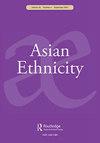身份自豪与排斥:战后香港的跨界工艺与中国裁缝,1945-1970
IF 0.8
Q3 ETHNIC STUDIES
引用次数: 0
摘要
最近的研究表明,在国际化的城市空间中,身份是灵活的,移民往往能够顺利融合。但是,二战后移居香港的上海和广东裁缝发展了一种不同的身份转变轨迹。他们不是简单地基于共同的中国民族的主张而融入一个单一的社会集体,而是根据他们的原籍地形成了不同的散居身份。本文通过对上海裁缝的到来以及他们与广东裁缝在香港的互动问题的分析,表明了对基于地方的身份的自豪感以及强烈的排他性,促进了上海人社区对广东人的社会界限的维护。它认为,尽管两个移民社区都具有共同的中国特征,但原籍地被用作社会认同和区分的关键形式,为两个华人社区的融合创造了一个迄今仍无法逾越的障碍。本文章由计算机程序翻译,如有差异,请以英文原文为准。
Identity pride and exclusiveness: cross-border craftsmanship and Chinese tailors in post-war Hong Kong, 1945-1970
ABSTRACT Recent scholarship has shown that in cosmopolitan urban spaces, identities are flexible, and migrants often integrate smoothly. But Shanghainese and Cantonese tailors who migrated to Hong Kong after World War II developed a different trajectory of identity transformation. Instead of simply integrating into a single social collectivity based on claims to a common Chinese ethnicity, they forged separate diasporic identities according to their places of origin. By problematising the arrival of Shanghainese tailors and their interactions with Cantonese tailors in Hong Kong, this article shows that pride in a place-based identity along with a strong sense of exclusiveness facilitated the maintenance of social boundaries by the Shanghainese community against the Cantonese. It argues that despite the common Chinese-ness of both migrant communities, place of origin was employed as a critical form of social identification and differentiation, creating an as-yet insurmountable barrier to the amalgamation of the two Chinese communities.
求助全文
通过发布文献求助,成功后即可免费获取论文全文。
去求助
来源期刊

Asian Ethnicity
PHYSIOLOGY-
CiteScore
2.80
自引率
6.20%
发文量
27
期刊介绍:
In the twenty-first century ethnic issues have assumed importance in many parts of the world. Until recently, questions of Asian ethnicity and identity have been treated in a balkanized fashion, with anthropologists, economists, historians, political scientists, sociologists and others publishing their studies in single-discipline journals. Asian Ethnicity provides a cross-disciplinary, international venue for the publication of well-researched articles about ethnic groups and ethnic relations in the half of the world where questions of ethnicity now loom largest. Asian Ethnicity covers any time period, although the greatest focus is expected to be on the twentieth and twenty-first centuries.
 求助内容:
求助内容: 应助结果提醒方式:
应助结果提醒方式:


